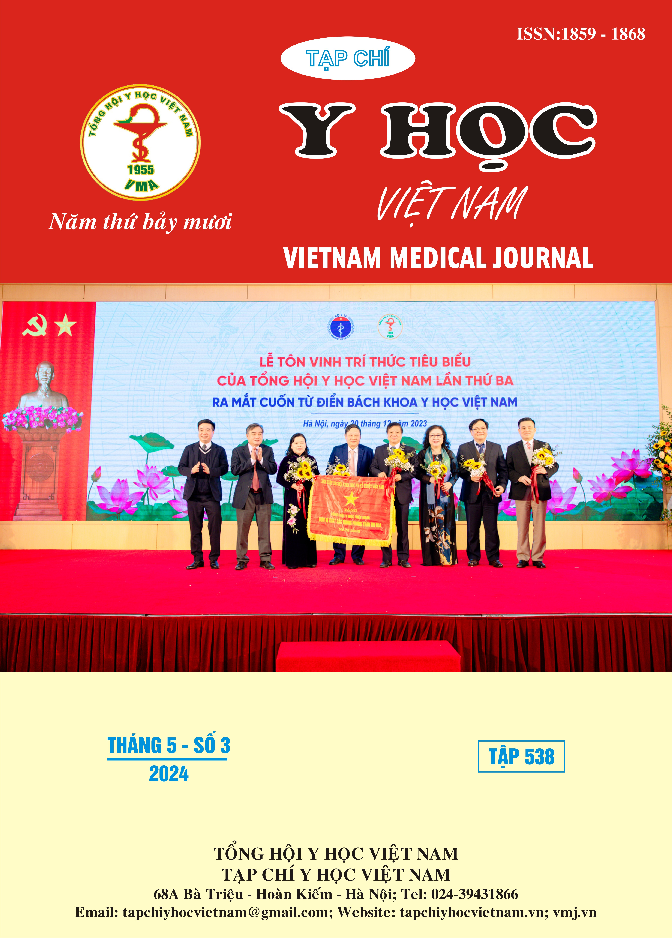STUDY ON CLINICAL, SUBCLINICAL AND THE RELATIONSHIP BETWEEN QTC CHANGES AND HEART DYSFUNCTION IN CANCER PATIENTS TREATING CHEMOTHERAPY WITH ANTHRACYCLINE
Main Article Content
Abstract
Background: Numerous studies have demonstrated an association between cardiac dysfunction and prolonged QTc interval during Anthracycline chemotherapy for cancer treatment. However, in Vietnam, data on this issue remains limited. Objectives: To describe clinical, subclinical characteristics and to investigate the correlation between QTc interval and cardiac dysfunction in cancer patients after one month of Anthracycline therapy. Materials and methods: A cross-sectional descriptive study was conducted on 36 chemotherapy patients with Anthracycline at Can Tho University of Medicine and Pharmacy Hospital and Can Tho Oncology Hospital in 2023. Results: The rates of dyspnea, dry cough, headache, anorexia, and hair loss after one month of Anthracycline treatment were 36,1%, 30,6%, 47,2%, 55,6%, and 58,3%, respectively, compared to 16,7%, 13,9%, 8,3%, 30,6%, and 5,6% before treatment, respectively (p<0,05). Similarly, laboratory parameters after one month of treatment compared to before treatment included red blood cell count (4,4±0,4 vs. 4,5±0,4), hemoglobin (12,3±1,4 vs. 12,9±1,3) (p<0,05), platelet count (426,1±143,1 vs. 343,6±103,3) (p<0,001), and creatinine (66,8±16,7 vs. 62,1±20,6) (p<0,05). Ten subjects had heart dysfunction after 1 month of chemotherapy with Anthracycline (27,8%). The QTc interval increased after one month of Anthracycline treatment compared to pre-treatment in both groups with and without heart dysfunction, but the difference in QTc values before and after treatment is not statistically significant in both groups with and without heart dysfunction. Conclusion: Symptoms after 1 month of Anthracycline chemotherapy (hair loss, loss of appetite, headaches, decreased red blood cell count, increased white blood cell count, and elevated creatinine) are more common compared to before treatment. The QTc interval after 1 month of Anthracycline treatment increases in both groups with and without heart dysfunction, but there is no statistically significant difference in QTc values before and after treatment in either group
Article Details
Keywords
Cancer, Anthracycline, QTc, cardiac dysfunction.
References
2. Crone SA, Zhao YY, Fan L, et al. ErbB2 is essential in the prevention of dilated cardiomyopathy. Nat Med. 2002; 8(5):459-465, doi: 10.1038/nm0502-459
3. Gadisa DA, Assefa M, Tefera GM, Yimer G. Patterns of Anthracycline-Based Chemotherapy-Induced Adverse Drug Reactions and Their Impact on Relative Dose Intensity among Women with Breast Cancer in Ethiopia: A Prospective Observational Study. J Oncol. 2020; 2020: 2636514, doi: 10.1155/2020/2636514
4. Kim P, Masha L, Olson A, et al. QT Prolongation in Cancer Patients. Front Cardiovasc Med. 2021; 8:613625, doi: 10.3389/fcvm. 2021.613625
5. Lancet JE, Uy GL, Cortes JE, et al. CPX-351 (cytarabine and daunorubicin) Liposome for Injection Versus Conventional Cytarabine Plus Daunorubicin in Older Patients With Newly Diagnosed Secondary Acute Myeloid Leukemia. J Clin Oncol. 2018;36(26):2684-2692, doi: 10.1200/ JCO.2017.77.6112
6. Liu C, Cheng B, Zhao G, Yuan H. Process analysis of anthracycline adverse reactions in breast cancer patients with postoperative chemotherapy. J Investig Med. 2022; 70(6): 1352-1357, doi: 10.1136/jim-2022-002339
7. Nakayama T, Oshima Y, Kusumoto S, et al. Clinical features of anthracycline-induced cardiotoxicity in patients with malignant lymphoma who received a CHOP regimen with or without rituximab: A single-center, retrospective observational study. eJHaem. 2020; 1(2): 498-506, doi: 10.1002/jha2.110
8. Saleh Y, Abdelkarim O, Herzallah K, Abela GS. Anthracycline-induced cardiotoxicity: mechanisms of action, incidence, risk factors, prevention, and treatment. Heart Fail Rev. 2021; 26(5):1159-1173 doi: 10.1007/s10741-020-09968-2


